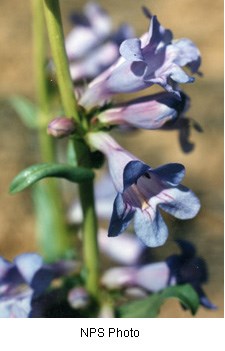
Penstemon cyanocaulis Family: Scrophulariaceae – Figwort Family Perennial herbs; some parasitic or semi-parasitic; 7.87” to 1.5' (2 to 4.5 decimeters) tall Leaves: opposite and basal; simple; leaf margins curled or wavy; 0.6” to 4.8” (1.5 to 12 cm) long; 0.08” to 1.2” (2 to 30 mm) wide Flowers: 5 blue or lavender lobed united tubular petals (irregular flowers with upper lip 2 lobed, lower lip 3 lobed), 5 tubular sepals at least partially united; 4 fertile stamens, a fifth stamen is sterile; flowers 0.64” to 0.96” (16 to 24 mm) long Pollinators: other genera in this family are pollinated by insects (specifically bees, flies, moths and butterflies) and hummingbirds Fruits: 2 chambered capsule (dry fruit) Blooms in Arches National Park: April, May, June Habitat in Arches National Park: desert shrub and pinyon-juniper communites; mostly in sandy soil Location seen: Windows primitive trail, park road in Salt Valley, outside Arches National Park above Ken's Lake Other: The genus name, “Penstemon”, is from the Greek “pen” which means “almost” and "stemon" which means “thread” which refers to the stamens (only 4 of the 5 stamens produce pollen; the fifth stamen is sterile, so it is almost a stamen). The species name, “cyanocaulis”, is from the Greek “kyanos” which means “blue” and “caulis” which means “stem”. The genus Penstemon is large and complex. The family is important because it has many ornamentals and cardiac glycosides can be derived from foxglove. |
Last updated: January 20, 2023
